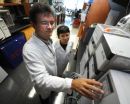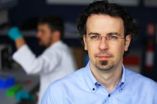(Press-News.org) Scientists at UCLA and the Technion, Israel's Institute of Technology, have unraveled how our brain cells encode the pronunciation of individual vowels in speech.
Published in the Aug. 21 edition of the journal Nature Communications, the discovery could lead to new technology that verbalizes the unspoken words of people paralyzed by injury or disease.
"We know that brain cells fire in a predictable way before we move our bodies," said Dr. Itzhak Fried, a professor of neurosurgery at the David Geffen School of Medicine at UCLA. "We hypothesized that neurons would also react differently when we pronounce specific sounds. If so, we may one day be able to decode these unique patterns of activity in the brain and translate them into speech."
Fried and the Technion's Ariel Tankus, formerly a postdoctoral researcher in Fried's lab at UCLA, followed 11 UCLA epilepsy patients who had electrodes implanted in their brains to pinpoint the origin of their seizures. The researchers recorded neuron activity as the patients uttered one of five vowels, or syllables containing the vowels.
With the Technion's Shy Shoham, the team studied how the neurons encoded vowel articulation at both the single-cell and collective level. The scientists found two areas — the superior temporal gyrus and a region in the medial frontal lobe — that housed neurons related to speech and attuned to vowels. The encoding in these sites, however, unfolded very differently.
Neurons in the superior temporal gyrus responded to all vowels, although at different rates of firing. In contrast, neurons that fired exclusively for only one or two vowels were located in the medial frontal region.
"Single-neuron activity in the medial frontal lobe corresponded to the encoding of specific vowels," Fried said. "The neuron would fire only when a particular vowel was spoken, but not other vowels."
At the collective level, neurons' encoding of vowels in the superior temporal gyrus reflected the anatomy that made speech possible — specifically, the tongue's position inside the mouth.
"Once we understand the neuronal code underlying speech, we can work backwards from brain-cell activity to decipher speech," said Fried. "This suggests an exciting possibility for people who are physically unable to speak. In the future, we may be able to construct neuro-prosthetic devices or brain-machine interfaces that decode a person's neuronal firing patterns and enable the person to communicate."
INFORMATION:
The study was supported by grants from the European Council, the U.S. National Institute of Neurological Disorders and Stroke, the Dana Foundation, and the Lady David and L. and L. Richmond research funds.
The authors declare no competing financial interests.
The UCLA Department of Neurosurgery is committed to providing the most comprehensive patient care through innovative clinical programs in minimally invasive brain and spinal surgery; neuroendoscopy; neuro-oncology for adult and pediatric brain tumors; cerebrovascular surgery; stereotactic radiosurgery for brain and spinal disorders; surgery for movement disorders such as Parkinson's disease; and epilepsy surgery. For 21 consecutive years, the department has been ranked among the top neurosurgery programs in the nation by U.S. News & World Report, including No. 1 in Los Angeles and No. 2 on the West Coast.
For more news, visit the UCLA Newsroom and follow us on Twitter.
END
Using bioluminescent proteins from a jellyfish, a team of scientists has lit up the inside of a neuron, capturing spectacular video footage that shows the movement of proteins throughout the cell.
The video offers a rare peek at how proteins, the brain's building blocks, are directed through neurons to renew its structure. It can be viewed online here: http://www.youtube.com/watch?v=baI9q2--q7s&feature=youtu.be
"Your brain is being disassembled and reassembled every day," said Don Arnold, associate professor of molecular and computational biology at the USC Dornsife ...
Knowing the position of missing oxygen atoms could be the key to cheaper solid oxide fuel cells with longer lifetimes. New microscopy research from the Department of Energy's Oak Ridge National Laboratory is enabling scientists to map these vacancies at an atomic scale.
Although fuel cells hold promise as an efficient energy conversion technology, they have yet to reach mainstream markets because of their high price tag and limited lifespans. Overcoming these barriers requires a fundamental understanding of fuel cells, which produce electricity through a chemical reaction ...
Augusta, GA—Researchers at the Georgia Health Sciences University Cancer Center have identified a gene that disrupts the inflammatory process implicated in liver cancer.
Laboratory mice bred without the gene lacked a pro-inflammatory protein called TREM-1 and protected them from developing liver cancer after exposure to carcinogens.
The study, published in Cancer Research, a journal for the American Association for Cancer Research, could lead to drug therapies to target TREM-1, said Dr. Anatolij Horuzsko, an immunologist at the GHSU Cancer Center and principal investigator ...
Washington, D.C.—Carnegie scientists are the first to discover the conditions under which nickel oxide can turn into an electricity-conducting metal. Nickel oxide is one of the first compounds to be studied for its electronic properties, but until now scientists have not been able to induce a metallic state. The compound becomes metallic at enormous pressures of 2.4 million times the atmospheric pressure (240 gigapascals). The finding is published in Physical Review Letters.
"Physicists have predicted for decades that the nickel oxide would transition from an insulator—a ...
Northwestern University scientists have connected 250 years of organic chemical knowledge into one giant computer network -- a chemical Google on steroids. This "immortal chemist" will never retire and take away its knowledge but instead will continue to learn, grow and share.
A decade in the making, the software optimizes syntheses of drug molecules and other important compounds, combines long (and expensive) syntheses of compounds into shorter and more economical routes and identifies suspicious chemical recipes that could lead to chemical weapons.
"I realized that ...
Enzymes involved in breaking down fat can now be manipulated to work three times harder by turning on a molecular switch recently observed by chemists at the University of Copenhagen. Being able to control this chemical on/off button could have massive implications for curing diseases related to obesity including diabetes, cardio vascular disease, stroke and even skin problems like acne. But the implications may be wider.
The results suggest that the switch may be a common characteristic of many more enzymes. Since enzymes are miniscule worker-molecules that control a ...
AUDIO:
This is a gibbon call without helium.
Click here for more information.
Have you ever heard an opera singing ape? Researchers in Japan have discovered that singing gibbons use the same vocal techniques as professional soprano singers. The study, published in the American Journal of Physical Anthropology, explains how recording gibbons singing under the influence of helium gas reveals a physiological similarity to human voices.
The research was led by Dr Takeshi Nishimura ...
Philadelphia, PA, August 23, 2012 – The routine use of prostate specific antigen (PSA) testing for screening and monitoring prostate cancer has led to early and more sensitive detection of the disease. A new study published in The Journal of Urology® reports that in the "PSA era," survival has improved for patients with newly diagnosed prostate cancer that has spread to the bones or other parts of the body and the disparity between African American and Caucasian men has been resolved.
"Our analysis indicates an overall improvement in risk adjusted survival rates for ...
Reducing tillage for some Central Great Plains crops could help conserve water and reduce losses caused by climate change, according to studies at the U.S. Department of Agriculture (USDA).
Research leader Laj Ahuja and others at the Agricultural Research Service (ARS) Agricultural Systems Research Unit at Fort Collins, Colo., superimposed climate projections onto 15 to 17 years of field data to see how future crop yields might be affected. ARS is USDA's chief intramural scientific research agency, and this work supports the USDA priority of responding to climate change.
The ...
To celebrate the upcoming birth of Adele's first child, Womensforum.com is launching a Facebook contest asking her legions of fans to guess what the Grammy Award-winning singer Adele will name her first baby.
Any entrant correctly guessing the baby's name gets a shot at winning a trip for two to Adele's hometown of London, England! The winning package includes round trip air fare for two and four nights in a luxury London hotel.
As a bonus, entrants who invite three or more friends to participate have a chance to win one of three Apple iPod Nano's loaded with Adele's ...

